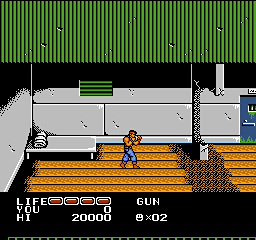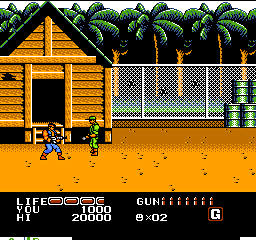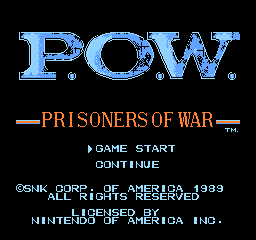
P.O.W: Prisoners of War (1989-)
Developer: SNK
Publisher: SNK
Genre: Beat 'Em up
P.O.W.: Prisoners of War for the NES was developed and published by SNK, arriving on the console in 1989 following the original arcade release in 1988. The NES version adapts the side-scrolling action of the coin-op game while adding several exclusive features not found in the arcade edition, making it a distinct interpretation rather than a direct port. As with many NES conversions of arcade beat-’em-ups, the developers adjusted the pacing and structure to suit home play instead of short-session arcade design.
The game follows a captured soldier who escapes from an enemy prison camp and fights his way through a series of fortified areas in an attempt to disrupt hostile operations. Its inspiration clearly stems from classic action films involving daring escapes and guerrilla combat, as well as the arcade tradition of one-man-army brawlers. The NES release expands on the story with additional weapon types and more varied level layouts, giving the adventure greater scope than its arcade counterpart.
Gameplay consists of hand-to-hand fighting, projectile attacks, and the use of enemy weapons such as rifles, grenades, and knives. The NES version introduces new moves like the high kick and the shoulder tackle, adding welcome variety to close-quarters combat. Levels include both outdoor bases and interior strongholds, each filled with enemies who require different tactics to defeat. The absence of multiplayer, which existed in the arcade original, changes the dynamic but places greater emphasis on timing and efficient enemy handling.
The soundtrack features driving, energetic compositions that match the game’s military action theme, using strong rhythmic motifs to underscore tense encounters. Sound effects highlight weapon use and physical strikes, helping reinforce the impact of combat. While the game had no sequels on the NES, it remains part of SNK’s broader catalogue of late-1980s action titles. Promotion focused mainly on print advertising and the strength of the SNK arcade brand. Reception at release was generally positive, with players praising its challenge and atmosphere, though some noted the increased difficulty and lack of co-op compared to the arcade original.
Images from MobyGames
Buy P.O.W: Prisoners of War
Click one of the Ebay or Amazon buttons below to check the latest prices and purchase P.O.W: Prisoners of War for the Nintendo Entertainment System.

Related Searches
P.O.W: Prisoners of War NES Download
P.O.W: Prisoners of War is available to purchase and download from a range of vendors. Always shop around...
P.O.W: Prisoners of War NES Manual
Various repositories around the internet have scanned and archived a range of retro manuals. Search now to.....
P.O.W: Prisoners of War NES Rom
We don't host or link to rom sites for this game. However, there are many sites out there that may be...
P.O.W: Prisoners of War NES Walkthrough
Many sites - particularly YouTube - host a range of walkthrough videos to guide you in your quest to get...
P.O.W: Prisoners of War NES Cheats
There are various sites out there that can offer cheat codes for games. Search now to find all available...
P.O.W: Prisoners of War NES Controls
This information can often be obtained through the user manual. Alternatively there are many sites out there...
P.O.W: Prisoners of War NES Release Date
The initial release date for P.O.W: Prisoners of War is stated as September 1989. Other ports of the game may..
P.O.W: Prisoners of War NES Review
There are many sites out there that have collated and documented historic reviews of this game. Search now...
P.O.W: Prisoners of War Famicom
As a Nintendo Entertainment System release, this game was also likely also available on the Famicom. This....
P.O.W: Prisoners of War NES Speedrun
There is now a community of competitive speedrunners who will try and gain the fastest possible time on their....








